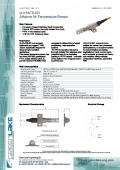gle/AATS-001
Airborne Air Temperature Sensor
Main Features · Compact & Rugged Stainless Steel Construction · Ceramic RTD sensor thermally isolated from body
· PTFE 4-wire shielded cable · 1/10 DIN RTD Tolerance Class |
Overview
gle/AATS-001 is a compact, lightweight and rugged PT100 probe, specifically designed for airborne instrumentation.
This precise temperature sensor has four wires, PTFE coated and shielded cable, to provide maximum flexibility when connected to different kind of signal conditioning / data-acquisition systems.
The RTD temperature element is thermally isolated from stainless steel protection body by an insulating bushing in PEEK material. It consists of fine platinum wire wrapped around a ceramic core.
gle/AATS-001, moreover to be suitable for manned and unmanned aerial platforms, is an optimal solution for instrumentation and testing applications in harsh environments, as for example: armoured and heavy-duty vehicles, railway vehicles, construction machinery, automotive R&D…
Mechanical details
Main Characteristics
|
Measurement range |
-50 °C to +200° C per 1/10 DIN (1/10 Class B) / -100 °C to +450 °C per class A |
|
Operating temperature range |
-200 °C to +600 °C |
|
Nominal resistance |
100 Ohm @ 0°C |
|
Lead material |
Platinum Plated Palladium |
|
Recommended current |
1mA |
|
Temperature coefficient |
0.003851 |
|
Ice point resistance |
100 ± 0.003? |
|
Self-Heating effect |
In still air 330 mK/mW |
|
Response time (50%) |
Air @1m/s 6 seconds |
|
Response time (50%) |
Water @0.4m/s 0.25 seconds |
|
Repeatability / Stability |
Meets the requirements of IEC 6075:2008 (6.4.2) |
|
Shock / Vibration |
Designed to withstand up to 40 g / 20 g per MIL-STD 810F |
|
Materials |
Stainless Steel body with ceramic RTD thermally isolated by a PEEK bushing |
|
Electrical connections |
4-wire free leads 24awg, M27500 specification PTFE coated shielded cable, 60 cm long |
Due to continuous developments, specifications are subject to change without prior notice. This product is not intended for applications whose its failure to perform can be expected to cause damages to properties and/or persons and/or injury to human life.






